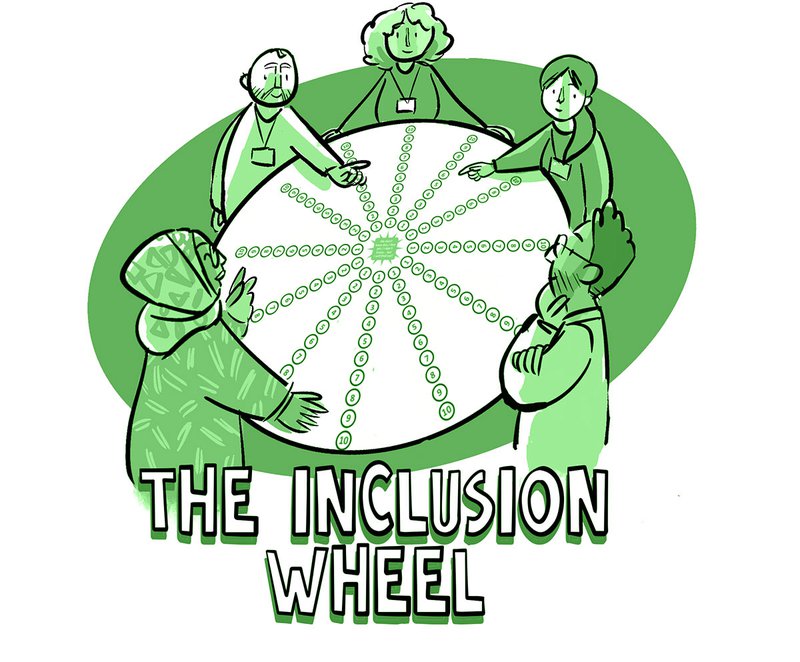The inclusion wheel
The Inclusion Wheel is a tool for organisational reflection.
Developed for Explore Your Universe, it has since been translated into a number of different languages and used across Europe in a movement towards more equitable working in science centres and science museums within ‘Ecsite’ (the European network of science centres). A simple and enjoyable tool to use, practitioners within this programme discussed within their teams where they place themselves, and shared their reflections at the start and end of the project.
The Inclusion Wheel is an excellent tool for organisational reflection. I used it with several centres, discussing all 12 spokes across different breakout groups. This encourages a more holistic understanding among staff and community partners of what EDI means in practice and how it impacts all parts of the organisation. It is a great way to start a conversation about where an organisation currently is and about achievable, incremental change.
Piotr Bienkowski, Director of Our Museum programme, cultural consultant
Learning from the wider sector
The co-produced ‘DiverSci’ Framework (chosen to emphasise Diversity, Inclusion, Values, Equity & Responsibility in Science Communication) supports progression towards organisation-wide, long-term change. There are five key areas that European science and discovery centres, museums and networks consider important to address in order to truly move towards becoming more diverse, inclusive, equitable and accessible organisations. These key and overlapping areas are Access, Content, Partnerships, Staff and Strategy. Explore a ‘first aid kit’ for frequently encountered EDI situations, indicators of inspiring practice, tools, case studies and a community of practice at diversci.eu
It's certainly kick-started something that the Centre wouldn't have been able to do.
Practitioner, Cambridge Science Centre

The changes that stuck from Explore Your Universe
The most consistently and significantly increased areas of the Inclusion Wheel, demonstrating a shift during this time frame in organisational practice, related to the following questions:
- Does your content reflect the diversity of your organisation’s catchment?
- Whose responsibility is it to promote diversity, equity and inclusion in your organisation?
- Who decides on the content of your events, activities and exhibits?
- What mechanisms are in place to share the learning from events and activities within your organisation?
- Is equity, inclusion and participatory practice referred to in your top-level statements (e.g. vision and mission or strategic objectives)?
Areas that still demonstrated minor improvement across the project partners, but appeared harder to progress during this timescale, included the following questions:
- Do your staff and governing body reflect your local community diversity in terms of genders, ethnic and social backgrounds and abilities?
- How do you know your organisation is making an impact with this work?
- How is your work partnering with local communities funded?
- Does your science centre leadership champion equity, inclusion and your work with local and / or diverse communities?
We had changes in our team and our partners during EYU4 and Covid caused disruption too. Yet, we have a flourishing and ongoing relationship with our community partner. We have a great dialogue with the community gatekeepers and we are still active in the community every week. The young people of that area are increasingly taking ownership of both STEM and the dynamic with our team.
Practitioner, Cambridge Science Centre
Links and downloads
- The ASDC Inclusion Wheel (English) (PDF, 957.9kB)
- The ASDC Inclusion Wheel (Dutch) (PDF, 1013.0kB)
- The ASDC Inclusion Wheel (Portuguese) (PDF, 961.0kB)
- The ASDC Inclusion Wheel (German) (PDF, 946.3kB)
